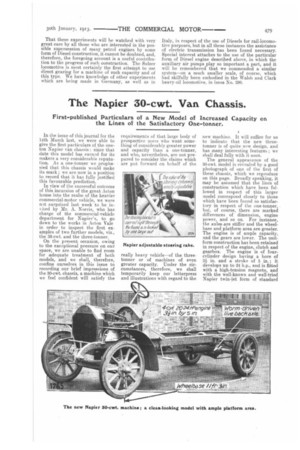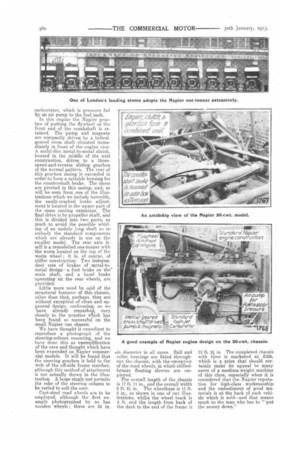The Napier 30-cwt. Van Chassis.
Page 19

Page 20

If you've noticed an error in this article please click here to report it so we can fix it.
First-published Particulars of a New Model of Increased Capacity on the Lines of the Satisfactory One-tonner.
In the issue of this journal for the 14th March last., we were able to give the first particulars of the oneton Napier van chassis: since that date this model has earned for its makers a very considerable reputation. As a one-tonner we prophesied that this chassis would make its mark ; we are now in a position to record that it has fully justified this favourable prediction.
In view of the successful outcome of this incursion of the great Acton house into the realm of the heavier commercial-motor vehicle, we were not surprised last week to be invited by Mr. A. Norris, who has charge of the commercial-vehicle department for Napier's, to go down to the works in Acton Vale in order to inspect the first examples of two further models, viz., the 30-cwt. and the three-tonner.
On the present occasion, owing to the exceptional pressure on our space, we are unable to find room for adequate treatment of both models, and we shall, therefore, confine ourselves in this issue to recording our brief impressions of the 20-cwt. chassis, a machine which we feel confident will satisfy the
requirements of that large body of prospective users who want something of considerably greater power and capacity than a one-tonner, and who, nevertheless, are not prepared to consider the claims which are put forward on behalf of the
really heavy vehicle—of the threetonner or of machines of even greater capacity. Under the circumstances, therefore, we shall temporarily keep our letterpress and illustrations with regard to the new machine. It will suffice for us to indicate that the new threetonner is of quite new design, and has many interesting features ; we shall deal fully with it soon.
The general appearance of the 30-cwt. model is revealed by a good photograph of one of the first of these chassis, which we reproduce on this page. Broadly speaking, it may be assumed that the lines of construction which have been followed in respect of this larger model correspond closely to those which have been found so satisfactory in respect of the one-tonner, but, of course, there are marked differences of dimension, engine power, and so on. For instance, the axles are stiffer and the wheelbase and platform area are greater. The engine is of ample capacity, and the gears are lower. The unitform construction has been retained in respect of the engine, clutch and gearbox. The engine is of fourcylinder design having a bore of 3-i in. and a stroke of 5 ; it develops up to 24 h.p., and is fitted with a high-tension magneto, and with the well-known and well-tried Napier twin-jet form of standard
carburetter, which is pressure fed by an air pump to the fuel tank.
In this engine the Napier practice of putting the flywheel at the front end of the crankshaft is retained, The punip and magneto are compactly driven by a helicalgeared cross shaft situated immediately in front of the engine case. A multi-die metal-to-metal clutch, housed in the middle of the unit construction, drives to a threespeed-and-reverse sliding gearbox of the normal pattern. The rear of this gearbox casing is extended in order to form a suitable housing for the countershaft brake. The shoes are pivoted in this casing, and, as will be seen from one of the illustrations which we include herewith, the easily-reached brake adjustment is located in the upper part of the same casting extension. The final drive is by propeller shaft, and this is divided into two parts, as much to avoid the possible -whirling of an unduly long shaft as to embody the standard components which are already in use on the smaller model. The rear axle itself is a remodelled one-tonner with the worm located on the top of the worm wheel ; it is, of course, of stiffer construction. Two independent sets of brakes of metal-tometal design—a foot brake on the main shaft, and a hand brake 'operating on the rear wheels, are provided.
Little more need he said of the structural features of this chassis, other than that, perhaps, they are without exception of clean and approved design, conforming, as we have already remarked, very closely to the practice Which has been found so successful on the small Napier van chassis.
We have thought it expedient to reproduce a photograph of the steering-column mounting, and we have done this as exemplification of the care and thought which have been expended on Napier commercial models. It will be found that the steering gearbox is held to the web of the off-side frame member, although this method of attachment is not actually shown in the illustration. A large single nut permits the rake of the steering column to be varied to suit the user.
Cast-steel road wheels are to be employed, although the first example photographed by us has wooden wheels;. these are 34 in. ...in diameter in all cases. Ball and roller bearings are fitted throughout the chassis, with the exception Of the road wheels, in which chilledbronze floating sleeves are employed.
The overall length of the chassis is 17 fL 11 in., and the overall width 6 ft. 61 in. The wheelbase is n ft. 3 in., as shown in one of our illustrations, whilst the wheel track is 5 ft. and the length from back of the dash to the end of the frame is 13 ft. 2 in. The completed chassis with tires is marketed at £435, which is a price that should certainly make its appeal to many users of a medium-weight machine of this class, especially when it is considered that the Napier reputation for high-class workmanship and the embodiment of good materials is at the back of each vehicle which is sold—and that means much to the man who has to "put the money down."




























